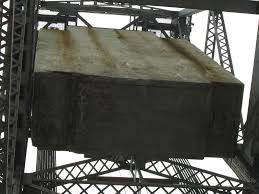The Burlington-Bristol Bridge and a Texan’s passion to build it.
Every time Peter Fritz passes a certain riverside cottage on Delaware Avenue in Delanco, N.J., he thinks of a man whose impact on both sides of the Delaware River is largely forgotten. The American Army colonel built the cottage. Without him, a nearby bridge linking Bucks and Burlington counties might never have been built.
Peter, who is secretary of the Delanco Historic Preservation Advisory Board, contacted me a few months ago after reading my column about the Burlington-Bristol Bridge built during the Great Depression. He urged me to write about the visionary behind the span. With Pete’s help and that of Sascha Harding, engineering director at the Burlington County Bridge Commission, the story of Lloyd Augustus Cross comes into focus.

Born in Texas in 1889, he was the son of a mechanical engineer who built dams and mining projects in northern Mexico. After his family moved to Connecticut, he entered the University of Pennsylvania where he was a record-setting track and field athlete. Graduating with a degree in civil engineering in 1914, he joined McClintock & Marshall, a bridge construction firm in Pittsburgh. He also enlisted in the Pennsylvania National Guard. In 1917 he deployed to France in World War I as an Army Corps of Engineers captain. He saw action in the Battle of Saint-Mihiel and Battle of Meuse Argonne, the second deadliest engagement in American history with the loss of 26,277 lives. It marked the first time the term “D-Day” was used by the Allies, the same designation employed 27 years later for the Allied invasion of Normandy in World War II.
After the war, Cross was chief of the Army Engineers Office in the War Department in Washington. Honorably discharged in 1920, he took a job with American Stores, a supermarket holding company in Philadelphia. Four years later, he and wife Frances Kirk built their unique pebble stone cottage in Delanco opposite Andalusia in Pennsylvania.
Cross became obsessed with building a bridge between bustling Bristol and Burlington City. He was inspired by the four-lane Tacony-Palmyra Bridge going up 5 miles below Delanco. Bristol and Burlington City long had hungered for a similar bridge to replace an historic ferry servicing the sister cities. Cross headed one of two groups vying to build the span. His original concept was a 4-lane structure with a central lift span connecting Bristol’s Market Street to Burlington Island and a second span connecting the island to Burlington. The other group favored a more expensive four-lane suspension bridge high enough to enable ships to easily pass under. Using his influence in Washington, the colonel obtained permission from the War Department to build a privately-funded interstate span but refused to choose a design. “The War department would not pick one over the other,” explained Harding. “The department said, ‘You guys get together and decide on a plan.’ ” Harding believes the suspension bridge would have been built had not Cross’ rival group existed.
Amid all this, Burlington City worried about demolition of historic structures and businesses. Bristol expressed concern about the close proximity of the Fleetwing aircraft factory and air field to the bridge. The two bridge groups ultimately agreed on a singular, 4-lane lift span to be built a half-mile downstream from Burlington Island.
Then calamity stuck.
The stock market collapse of 1929 made it nearly impossible to finance the toll bridge. Through previous employer McClintock & Marshall, Cross secured a $1.5 million loan. The corporation also became prime contractor. Cross and associates scaled back the design to a less expensive two-lane span connecting Route 413 in Bristol Township to Reed Street in Burlington. The plan incorporated two towers from which massive concrete counterweights would raise a central lift span to clear ocean-going freighters. It would be similar to the Conrail Delair Railroad Bridge between Philadelphia and Camden built in 1896.

The Burlington-Bristol Bridge would stretch the length of eight football fields. It was completed in just 13 months and opened to traffic on May 2, 1931. Cross became secretary for the Burlington-Bristol Bridge Co. and managed the bridge for years. In 1941, the Army re-activated him at the outset of World War II. He served in the North Pacific as commander of the 304th Engineers, retiring as a colonel. He continued to reside in his dream cottage on the Delaware until his passing in 1972.
Today, the Burlington-Bristol Bridge and the Tacony-Palmyra Bridge are managed by the Burlington County Bridge Commission. Recalling the colonel’s impact local is important, according to Peter Fritz. “The Delanco History Board is documenting contributions made by our military veterans. Col. Lloyd Cross’ service with the Army Corps of Engineers spanned two world wars, between which he designed, funded, built and operated the Burlington-Bristol Bridge for 18 years. We’re honored to be able to tell his story.”
***
The use of “D-Day” as a command in World War I and II is discussed on the Web at https://american-history.net/world-war-2-ww2/d-day-landings-overview/d-day-meaning/


